Business Strategy Report: Analyzing John Lewis's Competitive Strategy
VerifiedAdded on 2021/01/02
|13
|4338
|321
Report
AI Summary
This report provides a comprehensive analysis of John Lewis's business strategy within the UK retail industry. It begins with an introduction to business strategy and its importance, followed by an examination of John Lewis's operations. The report then applies the PESTLE analysis to assess the external macro-environmental factors impacting the company, including political, economic, social, technological, legal, and environmental considerations. Subsequently, it utilizes SWOT analysis to evaluate John Lewis's internal strengths, weaknesses, opportunities, and threats. Finally, the VRIO model is employed to assess the company's resources and capabilities, offering insights into its competitive advantages. The report concludes by summarizing the key findings and implications for John Lewis's strategic planning and future success.
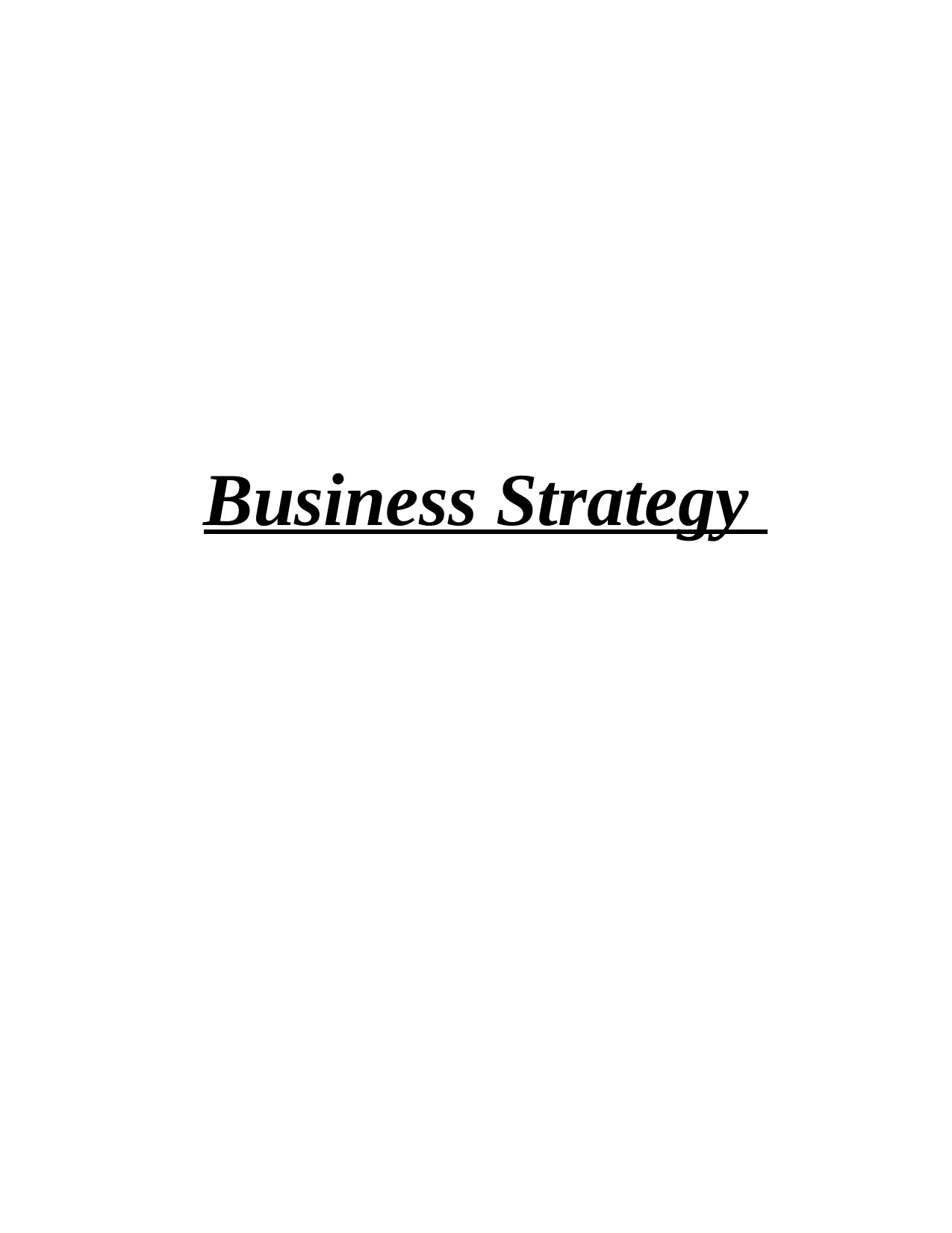
Business Strategy
Paraphrase This Document
Need a fresh take? Get an instant paraphrase of this document with our AI Paraphraser
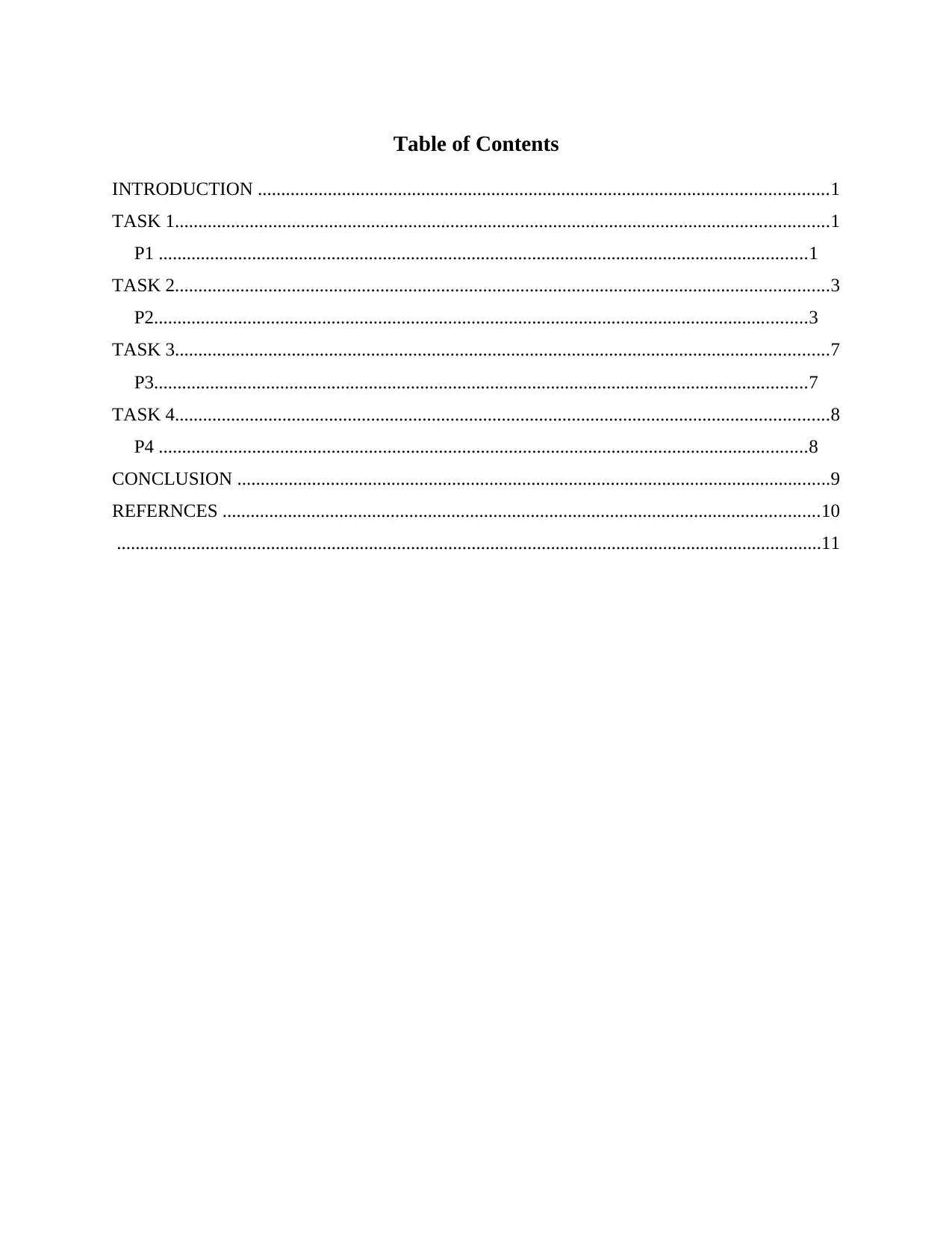
Table of Contents
INTRODUCTION ..........................................................................................................................1
TASK 1............................................................................................................................................1
P1 ...........................................................................................................................................1
TASK 2............................................................................................................................................3
P2............................................................................................................................................3
TASK 3............................................................................................................................................7
P3............................................................................................................................................7
TASK 4............................................................................................................................................8
P4 ...........................................................................................................................................8
CONCLUSION ...............................................................................................................................9
REFERNCES ................................................................................................................................10
.......................................................................................................................................................11
INTRODUCTION ..........................................................................................................................1
TASK 1............................................................................................................................................1
P1 ...........................................................................................................................................1
TASK 2............................................................................................................................................3
P2............................................................................................................................................3
TASK 3............................................................................................................................................7
P3............................................................................................................................................7
TASK 4............................................................................................................................................8
P4 ...........................................................................................................................................8
CONCLUSION ...............................................................................................................................9
REFERNCES ................................................................................................................................10
.......................................................................................................................................................11
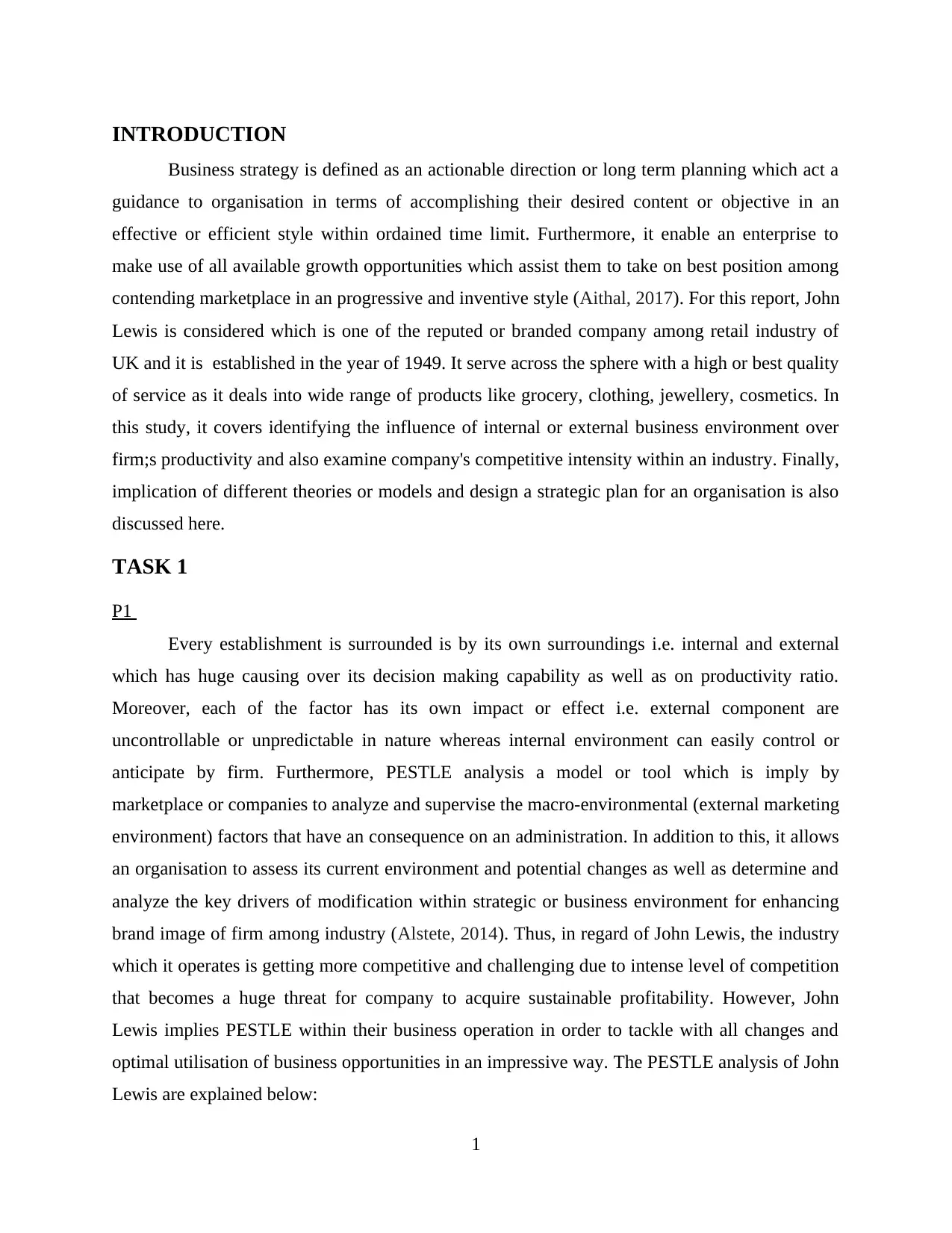
INTRODUCTION
Business strategy is defined as an actionable direction or long term planning which act a
guidance to organisation in terms of accomplishing their desired content or objective in an
effective or efficient style within ordained time limit. Furthermore, it enable an enterprise to
make use of all available growth opportunities which assist them to take on best position among
contending marketplace in an progressive and inventive style (Aithal, 2017). For this report, John
Lewis is considered which is one of the reputed or branded company among retail industry of
UK and it is established in the year of 1949. It serve across the sphere with a high or best quality
of service as it deals into wide range of products like grocery, clothing, jewellery, cosmetics. In
this study, it covers identifying the influence of internal or external business environment over
firm;s productivity and also examine company's competitive intensity within an industry. Finally,
implication of different theories or models and design a strategic plan for an organisation is also
discussed here.
TASK 1
P1
Every establishment is surrounded is by its own surroundings i.e. internal and external
which has huge causing over its decision making capability as well as on productivity ratio.
Moreover, each of the factor has its own impact or effect i.e. external component are
uncontrollable or unpredictable in nature whereas internal environment can easily control or
anticipate by firm. Furthermore, PESTLE analysis a model or tool which is imply by
marketplace or companies to analyze and supervise the macro-environmental (external marketing
environment) factors that have an consequence on an administration. In addition to this, it allows
an organisation to assess its current environment and potential changes as well as determine and
analyze the key drivers of modification within strategic or business environment for enhancing
brand image of firm among industry (Alstete, 2014). Thus, in regard of John Lewis, the industry
which it operates is getting more competitive and challenging due to intense level of competition
that becomes a huge threat for company to acquire sustainable profitability. However, John
Lewis implies PESTLE within their business operation in order to tackle with all changes and
optimal utilisation of business opportunities in an impressive way. The PESTLE analysis of John
Lewis are explained below:
1
Business strategy is defined as an actionable direction or long term planning which act a
guidance to organisation in terms of accomplishing their desired content or objective in an
effective or efficient style within ordained time limit. Furthermore, it enable an enterprise to
make use of all available growth opportunities which assist them to take on best position among
contending marketplace in an progressive and inventive style (Aithal, 2017). For this report, John
Lewis is considered which is one of the reputed or branded company among retail industry of
UK and it is established in the year of 1949. It serve across the sphere with a high or best quality
of service as it deals into wide range of products like grocery, clothing, jewellery, cosmetics. In
this study, it covers identifying the influence of internal or external business environment over
firm;s productivity and also examine company's competitive intensity within an industry. Finally,
implication of different theories or models and design a strategic plan for an organisation is also
discussed here.
TASK 1
P1
Every establishment is surrounded is by its own surroundings i.e. internal and external
which has huge causing over its decision making capability as well as on productivity ratio.
Moreover, each of the factor has its own impact or effect i.e. external component are
uncontrollable or unpredictable in nature whereas internal environment can easily control or
anticipate by firm. Furthermore, PESTLE analysis a model or tool which is imply by
marketplace or companies to analyze and supervise the macro-environmental (external marketing
environment) factors that have an consequence on an administration. In addition to this, it allows
an organisation to assess its current environment and potential changes as well as determine and
analyze the key drivers of modification within strategic or business environment for enhancing
brand image of firm among industry (Alstete, 2014). Thus, in regard of John Lewis, the industry
which it operates is getting more competitive and challenging due to intense level of competition
that becomes a huge threat for company to acquire sustainable profitability. However, John
Lewis implies PESTLE within their business operation in order to tackle with all changes and
optimal utilisation of business opportunities in an impressive way. The PESTLE analysis of John
Lewis are explained below:
1
⊘ This is a preview!⊘
Do you want full access?
Subscribe today to unlock all pages.

Trusted by 1+ million students worldwide
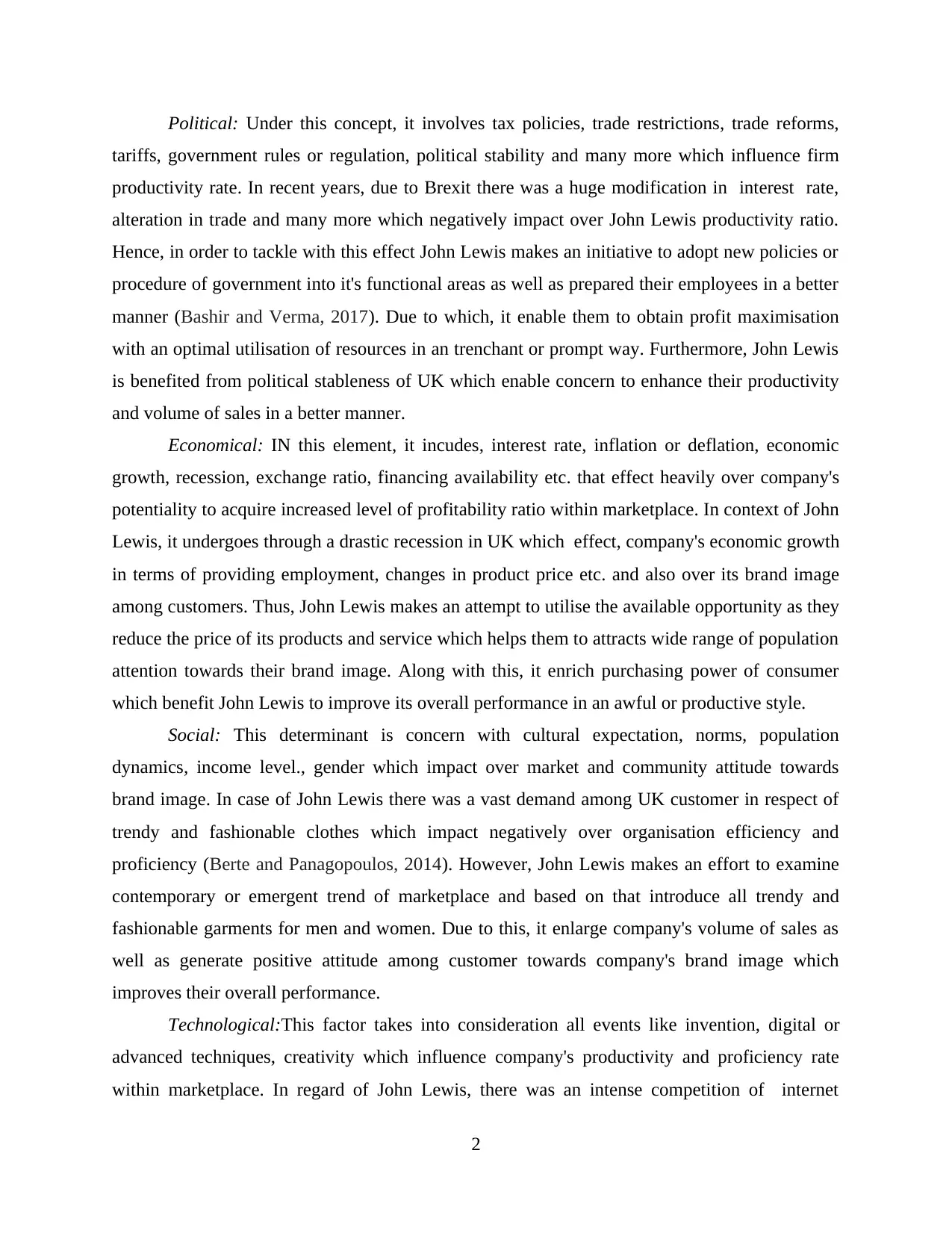
Political: Under this concept, it involves tax policies, trade restrictions, trade reforms,
tariffs, government rules or regulation, political stability and many more which influence firm
productivity rate. In recent years, due to Brexit there was a huge modification in interest rate,
alteration in trade and many more which negatively impact over John Lewis productivity ratio.
Hence, in order to tackle with this effect John Lewis makes an initiative to adopt new policies or
procedure of government into it's functional areas as well as prepared their employees in a better
manner (Bashir and Verma, 2017). Due to which, it enable them to obtain profit maximisation
with an optimal utilisation of resources in an trenchant or prompt way. Furthermore, John Lewis
is benefited from political stableness of UK which enable concern to enhance their productivity
and volume of sales in a better manner.
Economical: IN this element, it incudes, interest rate, inflation or deflation, economic
growth, recession, exchange ratio, financing availability etc. that effect heavily over company's
potentiality to acquire increased level of profitability ratio within marketplace. In context of John
Lewis, it undergoes through a drastic recession in UK which effect, company's economic growth
in terms of providing employment, changes in product price etc. and also over its brand image
among customers. Thus, John Lewis makes an attempt to utilise the available opportunity as they
reduce the price of its products and service which helps them to attracts wide range of population
attention towards their brand image. Along with this, it enrich purchasing power of consumer
which benefit John Lewis to improve its overall performance in an awful or productive style.
Social: This determinant is concern with cultural expectation, norms, population
dynamics, income level., gender which impact over market and community attitude towards
brand image. In case of John Lewis there was a vast demand among UK customer in respect of
trendy and fashionable clothes which impact negatively over organisation efficiency and
proficiency (Berte and Panagopoulos, 2014). However, John Lewis makes an effort to examine
contemporary or emergent trend of marketplace and based on that introduce all trendy and
fashionable garments for men and women. Due to this, it enlarge company's volume of sales as
well as generate positive attitude among customer towards company's brand image which
improves their overall performance.
Technological:This factor takes into consideration all events like invention, digital or
advanced techniques, creativity which influence company's productivity and proficiency rate
within marketplace. In regard of John Lewis, there was an intense competition of internet
2
tariffs, government rules or regulation, political stability and many more which influence firm
productivity rate. In recent years, due to Brexit there was a huge modification in interest rate,
alteration in trade and many more which negatively impact over John Lewis productivity ratio.
Hence, in order to tackle with this effect John Lewis makes an initiative to adopt new policies or
procedure of government into it's functional areas as well as prepared their employees in a better
manner (Bashir and Verma, 2017). Due to which, it enable them to obtain profit maximisation
with an optimal utilisation of resources in an trenchant or prompt way. Furthermore, John Lewis
is benefited from political stableness of UK which enable concern to enhance their productivity
and volume of sales in a better manner.
Economical: IN this element, it incudes, interest rate, inflation or deflation, economic
growth, recession, exchange ratio, financing availability etc. that effect heavily over company's
potentiality to acquire increased level of profitability ratio within marketplace. In context of John
Lewis, it undergoes through a drastic recession in UK which effect, company's economic growth
in terms of providing employment, changes in product price etc. and also over its brand image
among customers. Thus, John Lewis makes an attempt to utilise the available opportunity as they
reduce the price of its products and service which helps them to attracts wide range of population
attention towards their brand image. Along with this, it enrich purchasing power of consumer
which benefit John Lewis to improve its overall performance in an awful or productive style.
Social: This determinant is concern with cultural expectation, norms, population
dynamics, income level., gender which impact over market and community attitude towards
brand image. In case of John Lewis there was a vast demand among UK customer in respect of
trendy and fashionable clothes which impact negatively over organisation efficiency and
proficiency (Berte and Panagopoulos, 2014). However, John Lewis makes an effort to examine
contemporary or emergent trend of marketplace and based on that introduce all trendy and
fashionable garments for men and women. Due to this, it enlarge company's volume of sales as
well as generate positive attitude among customer towards company's brand image which
improves their overall performance.
Technological:This factor takes into consideration all events like invention, digital or
advanced techniques, creativity which influence company's productivity and proficiency rate
within marketplace. In regard of John Lewis, there was an intense competition of internet
2
Paraphrase This Document
Need a fresh take? Get an instant paraphrase of this document with our AI Paraphraser
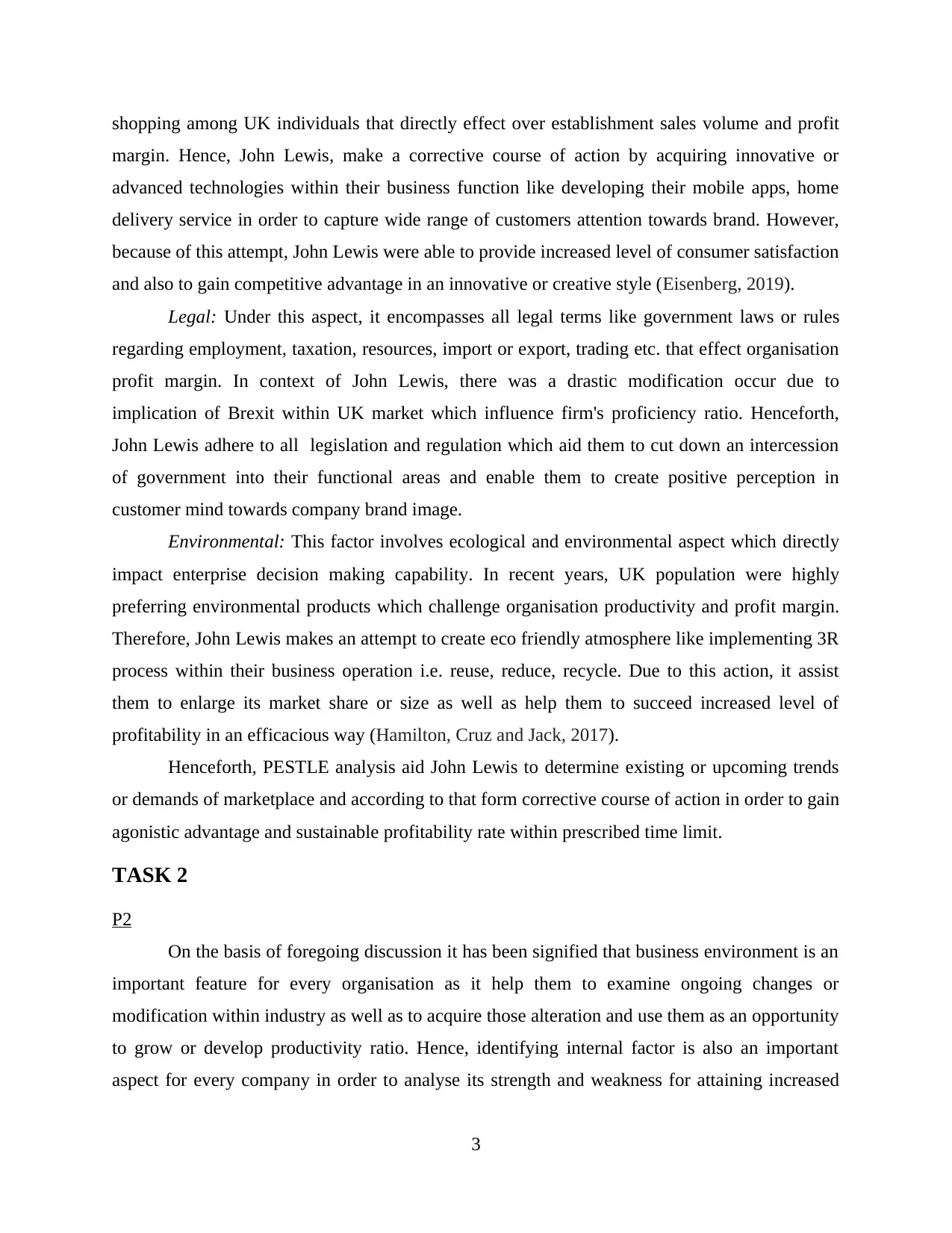
shopping among UK individuals that directly effect over establishment sales volume and profit
margin. Hence, John Lewis, make a corrective course of action by acquiring innovative or
advanced technologies within their business function like developing their mobile apps, home
delivery service in order to capture wide range of customers attention towards brand. However,
because of this attempt, John Lewis were able to provide increased level of consumer satisfaction
and also to gain competitive advantage in an innovative or creative style (Eisenberg, 2019).
Legal: Under this aspect, it encompasses all legal terms like government laws or rules
regarding employment, taxation, resources, import or export, trading etc. that effect organisation
profit margin. In context of John Lewis, there was a drastic modification occur due to
implication of Brexit within UK market which influence firm's proficiency ratio. Henceforth,
John Lewis adhere to all legislation and regulation which aid them to cut down an intercession
of government into their functional areas and enable them to create positive perception in
customer mind towards company brand image.
Environmental: This factor involves ecological and environmental aspect which directly
impact enterprise decision making capability. In recent years, UK population were highly
preferring environmental products which challenge organisation productivity and profit margin.
Therefore, John Lewis makes an attempt to create eco friendly atmosphere like implementing 3R
process within their business operation i.e. reuse, reduce, recycle. Due to this action, it assist
them to enlarge its market share or size as well as help them to succeed increased level of
profitability in an efficacious way (Hamilton, Cruz and Jack, 2017).
Henceforth, PESTLE analysis aid John Lewis to determine existing or upcoming trends
or demands of marketplace and according to that form corrective course of action in order to gain
agonistic advantage and sustainable profitability rate within prescribed time limit.
TASK 2
P2
On the basis of foregoing discussion it has been signified that business environment is an
important feature for every organisation as it help them to examine ongoing changes or
modification within industry as well as to acquire those alteration and use them as an opportunity
to grow or develop productivity ratio. Hence, identifying internal factor is also an important
aspect for every company in order to analyse its strength and weakness for attaining increased
3
margin. Hence, John Lewis, make a corrective course of action by acquiring innovative or
advanced technologies within their business function like developing their mobile apps, home
delivery service in order to capture wide range of customers attention towards brand. However,
because of this attempt, John Lewis were able to provide increased level of consumer satisfaction
and also to gain competitive advantage in an innovative or creative style (Eisenberg, 2019).
Legal: Under this aspect, it encompasses all legal terms like government laws or rules
regarding employment, taxation, resources, import or export, trading etc. that effect organisation
profit margin. In context of John Lewis, there was a drastic modification occur due to
implication of Brexit within UK market which influence firm's proficiency ratio. Henceforth,
John Lewis adhere to all legislation and regulation which aid them to cut down an intercession
of government into their functional areas and enable them to create positive perception in
customer mind towards company brand image.
Environmental: This factor involves ecological and environmental aspect which directly
impact enterprise decision making capability. In recent years, UK population were highly
preferring environmental products which challenge organisation productivity and profit margin.
Therefore, John Lewis makes an attempt to create eco friendly atmosphere like implementing 3R
process within their business operation i.e. reuse, reduce, recycle. Due to this action, it assist
them to enlarge its market share or size as well as help them to succeed increased level of
profitability in an efficacious way (Hamilton, Cruz and Jack, 2017).
Henceforth, PESTLE analysis aid John Lewis to determine existing or upcoming trends
or demands of marketplace and according to that form corrective course of action in order to gain
agonistic advantage and sustainable profitability rate within prescribed time limit.
TASK 2
P2
On the basis of foregoing discussion it has been signified that business environment is an
important feature for every organisation as it help them to examine ongoing changes or
modification within industry as well as to acquire those alteration and use them as an opportunity
to grow or develop productivity ratio. Hence, identifying internal factor is also an important
aspect for every company in order to analyse its strength and weakness for attaining increased
3
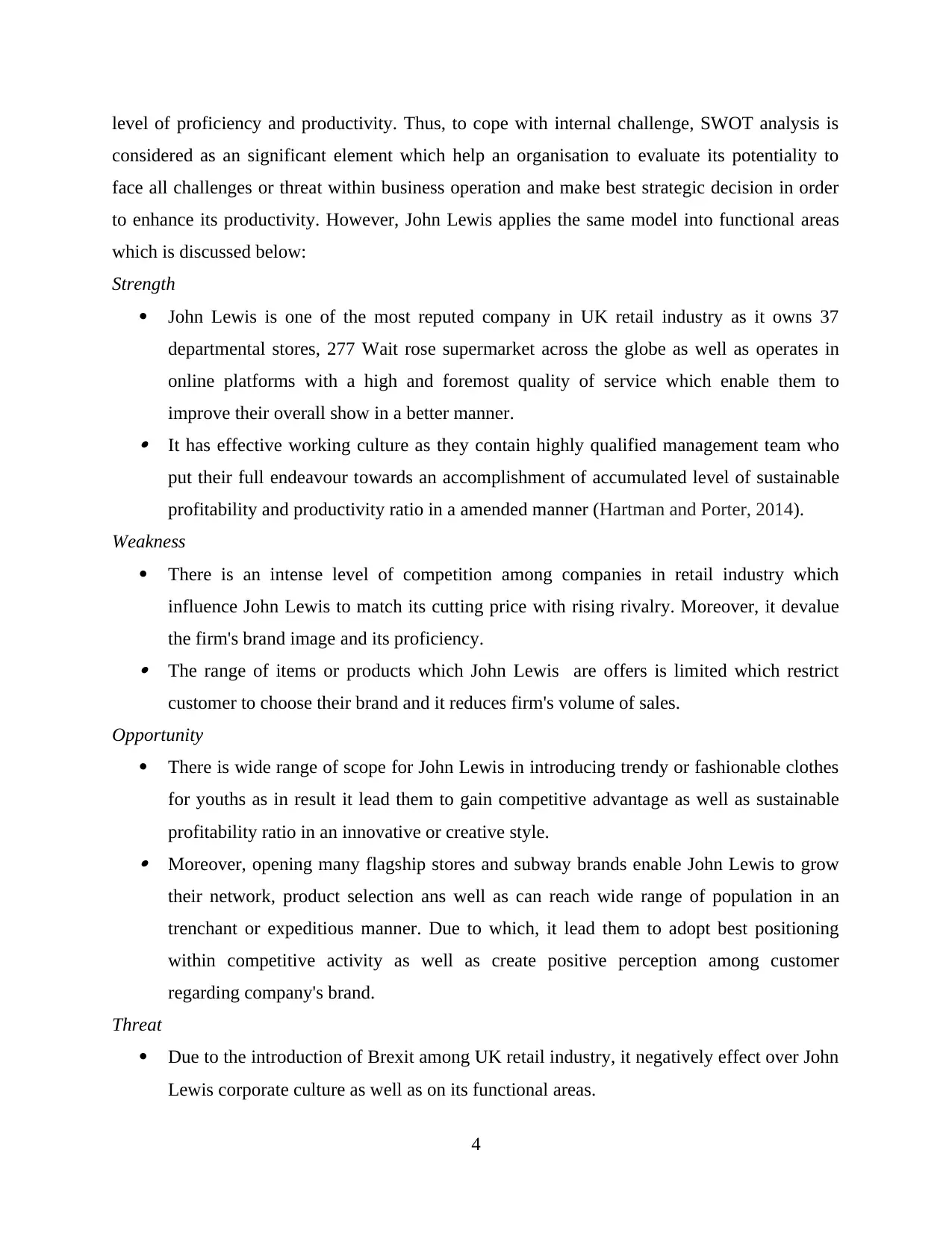
level of proficiency and productivity. Thus, to cope with internal challenge, SWOT analysis is
considered as an significant element which help an organisation to evaluate its potentiality to
face all challenges or threat within business operation and make best strategic decision in order
to enhance its productivity. However, John Lewis applies the same model into functional areas
which is discussed below:
Strength
John Lewis is one of the most reputed company in UK retail industry as it owns 37
departmental stores, 277 Wait rose supermarket across the globe as well as operates in
online platforms with a high and foremost quality of service which enable them to
improve their overall show in a better manner. It has effective working culture as they contain highly qualified management team who
put their full endeavour towards an accomplishment of accumulated level of sustainable
profitability and productivity ratio in a amended manner (Hartman and Porter, 2014).
Weakness
There is an intense level of competition among companies in retail industry which
influence John Lewis to match its cutting price with rising rivalry. Moreover, it devalue
the firm's brand image and its proficiency. The range of items or products which John Lewis are offers is limited which restrict
customer to choose their brand and it reduces firm's volume of sales.
Opportunity
There is wide range of scope for John Lewis in introducing trendy or fashionable clothes
for youths as in result it lead them to gain competitive advantage as well as sustainable
profitability ratio in an innovative or creative style. Moreover, opening many flagship stores and subway brands enable John Lewis to grow
their network, product selection ans well as can reach wide range of population in an
trenchant or expeditious manner. Due to which, it lead them to adopt best positioning
within competitive activity as well as create positive perception among customer
regarding company's brand.
Threat
Due to the introduction of Brexit among UK retail industry, it negatively effect over John
Lewis corporate culture as well as on its functional areas.
4
considered as an significant element which help an organisation to evaluate its potentiality to
face all challenges or threat within business operation and make best strategic decision in order
to enhance its productivity. However, John Lewis applies the same model into functional areas
which is discussed below:
Strength
John Lewis is one of the most reputed company in UK retail industry as it owns 37
departmental stores, 277 Wait rose supermarket across the globe as well as operates in
online platforms with a high and foremost quality of service which enable them to
improve their overall show in a better manner. It has effective working culture as they contain highly qualified management team who
put their full endeavour towards an accomplishment of accumulated level of sustainable
profitability and productivity ratio in a amended manner (Hartman and Porter, 2014).
Weakness
There is an intense level of competition among companies in retail industry which
influence John Lewis to match its cutting price with rising rivalry. Moreover, it devalue
the firm's brand image and its proficiency. The range of items or products which John Lewis are offers is limited which restrict
customer to choose their brand and it reduces firm's volume of sales.
Opportunity
There is wide range of scope for John Lewis in introducing trendy or fashionable clothes
for youths as in result it lead them to gain competitive advantage as well as sustainable
profitability ratio in an innovative or creative style. Moreover, opening many flagship stores and subway brands enable John Lewis to grow
their network, product selection ans well as can reach wide range of population in an
trenchant or expeditious manner. Due to which, it lead them to adopt best positioning
within competitive activity as well as create positive perception among customer
regarding company's brand.
Threat
Due to the introduction of Brexit among UK retail industry, it negatively effect over John
Lewis corporate culture as well as on its functional areas.
4
⊘ This is a preview!⊘
Do you want full access?
Subscribe today to unlock all pages.

Trusted by 1+ million students worldwide
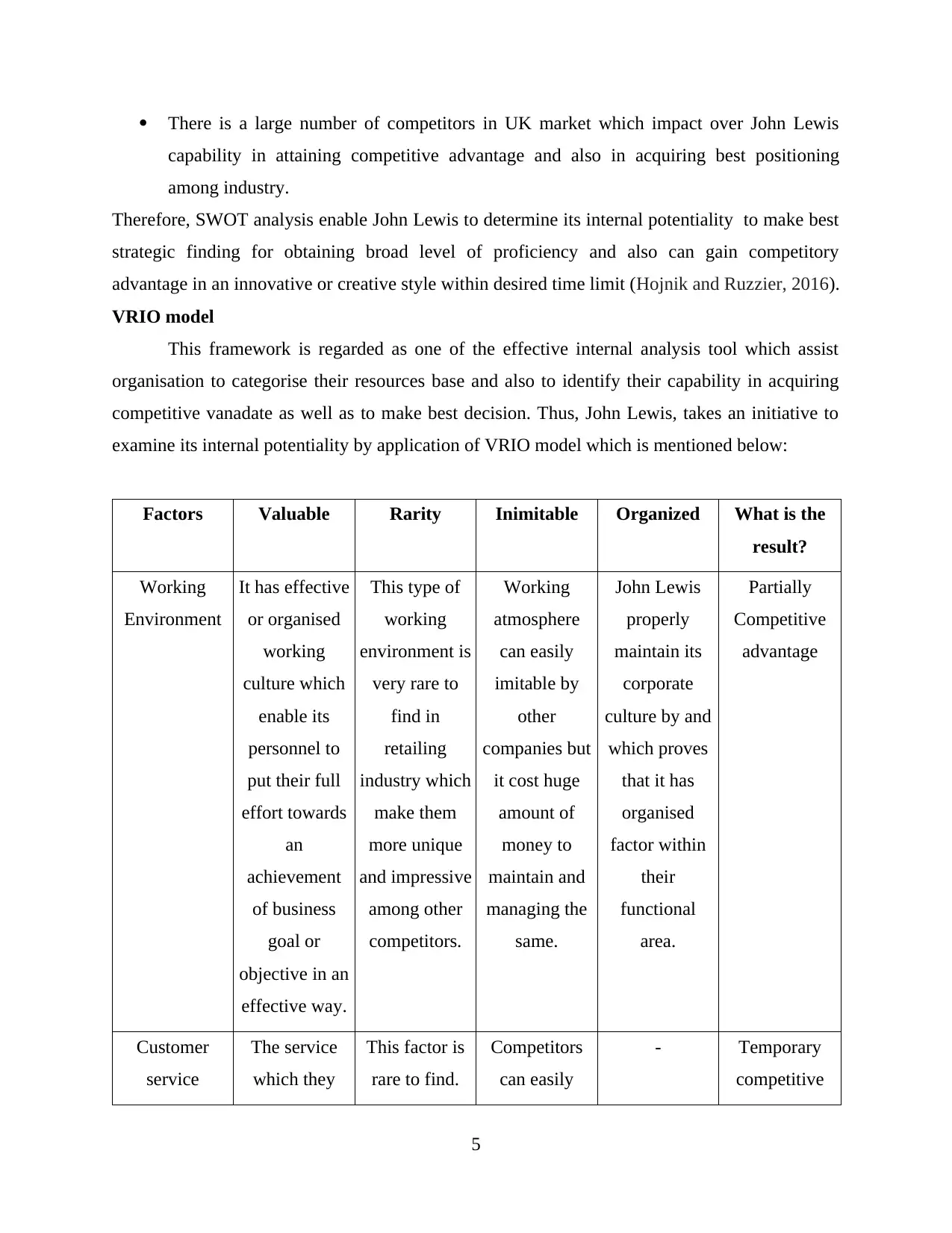
There is a large number of competitors in UK market which impact over John Lewis
capability in attaining competitive advantage and also in acquiring best positioning
among industry.
Therefore, SWOT analysis enable John Lewis to determine its internal potentiality to make best
strategic finding for obtaining broad level of proficiency and also can gain competitory
advantage in an innovative or creative style within desired time limit (Hojnik and Ruzzier, 2016).
VRIO model
This framework is regarded as one of the effective internal analysis tool which assist
organisation to categorise their resources base and also to identify their capability in acquiring
competitive vanadate as well as to make best decision. Thus, John Lewis, takes an initiative to
examine its internal potentiality by application of VRIO model which is mentioned below:
Factors Valuable Rarity Inimitable Organized What is the
result?
Working
Environment
It has effective
or organised
working
culture which
enable its
personnel to
put their full
effort towards
an
achievement
of business
goal or
objective in an
effective way.
This type of
working
environment is
very rare to
find in
retailing
industry which
make them
more unique
and impressive
among other
competitors.
Working
atmosphere
can easily
imitable by
other
companies but
it cost huge
amount of
money to
maintain and
managing the
same.
John Lewis
properly
maintain its
corporate
culture by and
which proves
that it has
organised
factor within
their
functional
area.
Partially
Competitive
advantage
Customer
service
The service
which they
This factor is
rare to find.
Competitors
can easily
- Temporary
competitive
5
capability in attaining competitive advantage and also in acquiring best positioning
among industry.
Therefore, SWOT analysis enable John Lewis to determine its internal potentiality to make best
strategic finding for obtaining broad level of proficiency and also can gain competitory
advantage in an innovative or creative style within desired time limit (Hojnik and Ruzzier, 2016).
VRIO model
This framework is regarded as one of the effective internal analysis tool which assist
organisation to categorise their resources base and also to identify their capability in acquiring
competitive vanadate as well as to make best decision. Thus, John Lewis, takes an initiative to
examine its internal potentiality by application of VRIO model which is mentioned below:
Factors Valuable Rarity Inimitable Organized What is the
result?
Working
Environment
It has effective
or organised
working
culture which
enable its
personnel to
put their full
effort towards
an
achievement
of business
goal or
objective in an
effective way.
This type of
working
environment is
very rare to
find in
retailing
industry which
make them
more unique
and impressive
among other
competitors.
Working
atmosphere
can easily
imitable by
other
companies but
it cost huge
amount of
money to
maintain and
managing the
same.
John Lewis
properly
maintain its
corporate
culture by and
which proves
that it has
organised
factor within
their
functional
area.
Partially
Competitive
advantage
Customer
service
The service
which they
This factor is
rare to find.
Competitors
can easily
- Temporary
competitive
5
Paraphrase This Document
Need a fresh take? Get an instant paraphrase of this document with our AI Paraphraser
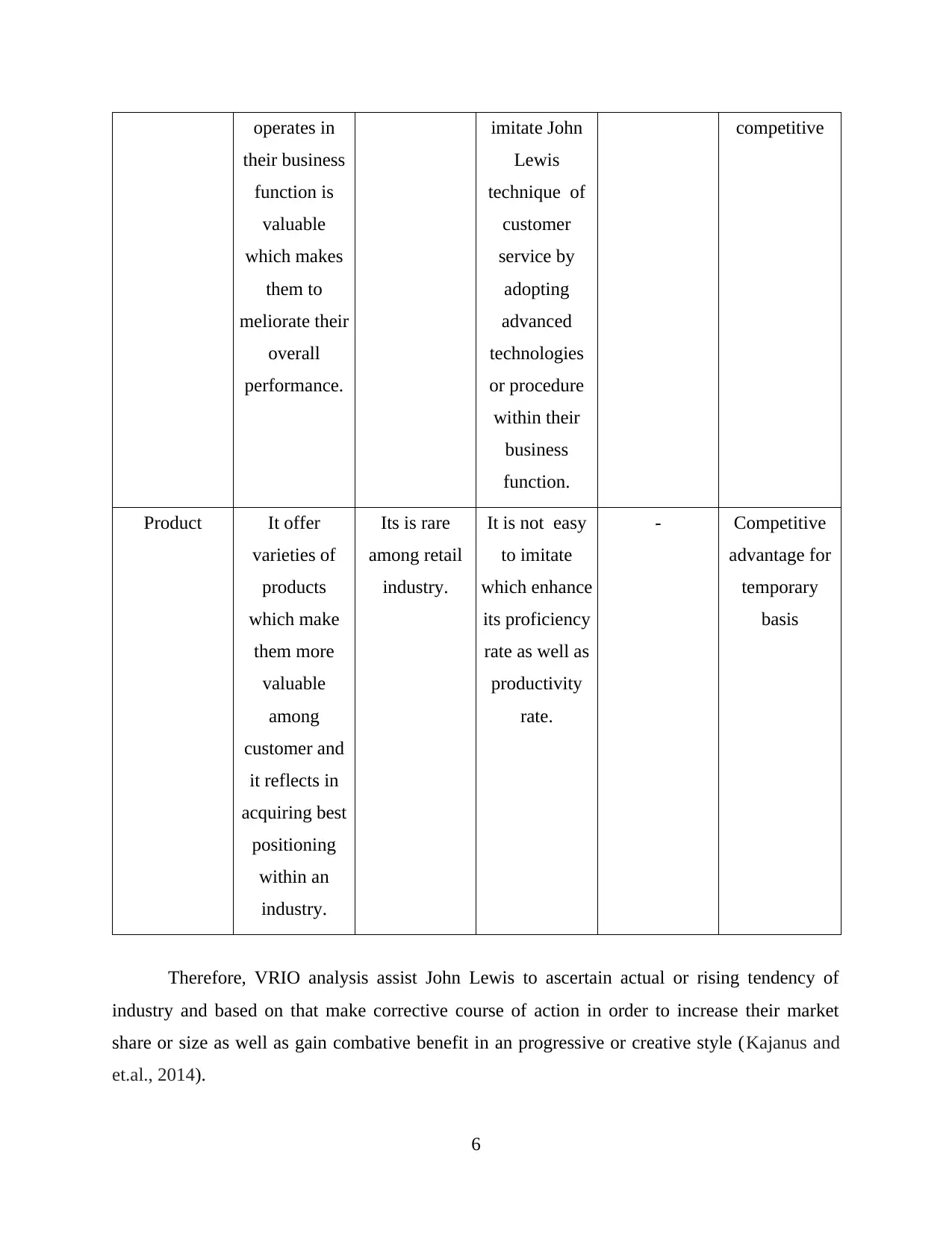
operates in
their business
function is
valuable
which makes
them to
meliorate their
overall
performance.
imitate John
Lewis
technique of
customer
service by
adopting
advanced
technologies
or procedure
within their
business
function.
competitive
Product It offer
varieties of
products
which make
them more
valuable
among
customer and
it reflects in
acquiring best
positioning
within an
industry.
Its is rare
among retail
industry.
It is not easy
to imitate
which enhance
its proficiency
rate as well as
productivity
rate.
- Competitive
advantage for
temporary
basis
Therefore, VRIO analysis assist John Lewis to ascertain actual or rising tendency of
industry and based on that make corrective course of action in order to increase their market
share or size as well as gain combative benefit in an progressive or creative style (Kajanus and
et.al., 2014).
6
their business
function is
valuable
which makes
them to
meliorate their
overall
performance.
imitate John
Lewis
technique of
customer
service by
adopting
advanced
technologies
or procedure
within their
business
function.
competitive
Product It offer
varieties of
products
which make
them more
valuable
among
customer and
it reflects in
acquiring best
positioning
within an
industry.
Its is rare
among retail
industry.
It is not easy
to imitate
which enhance
its proficiency
rate as well as
productivity
rate.
- Competitive
advantage for
temporary
basis
Therefore, VRIO analysis assist John Lewis to ascertain actual or rising tendency of
industry and based on that make corrective course of action in order to increase their market
share or size as well as gain combative benefit in an progressive or creative style (Kajanus and
et.al., 2014).
6
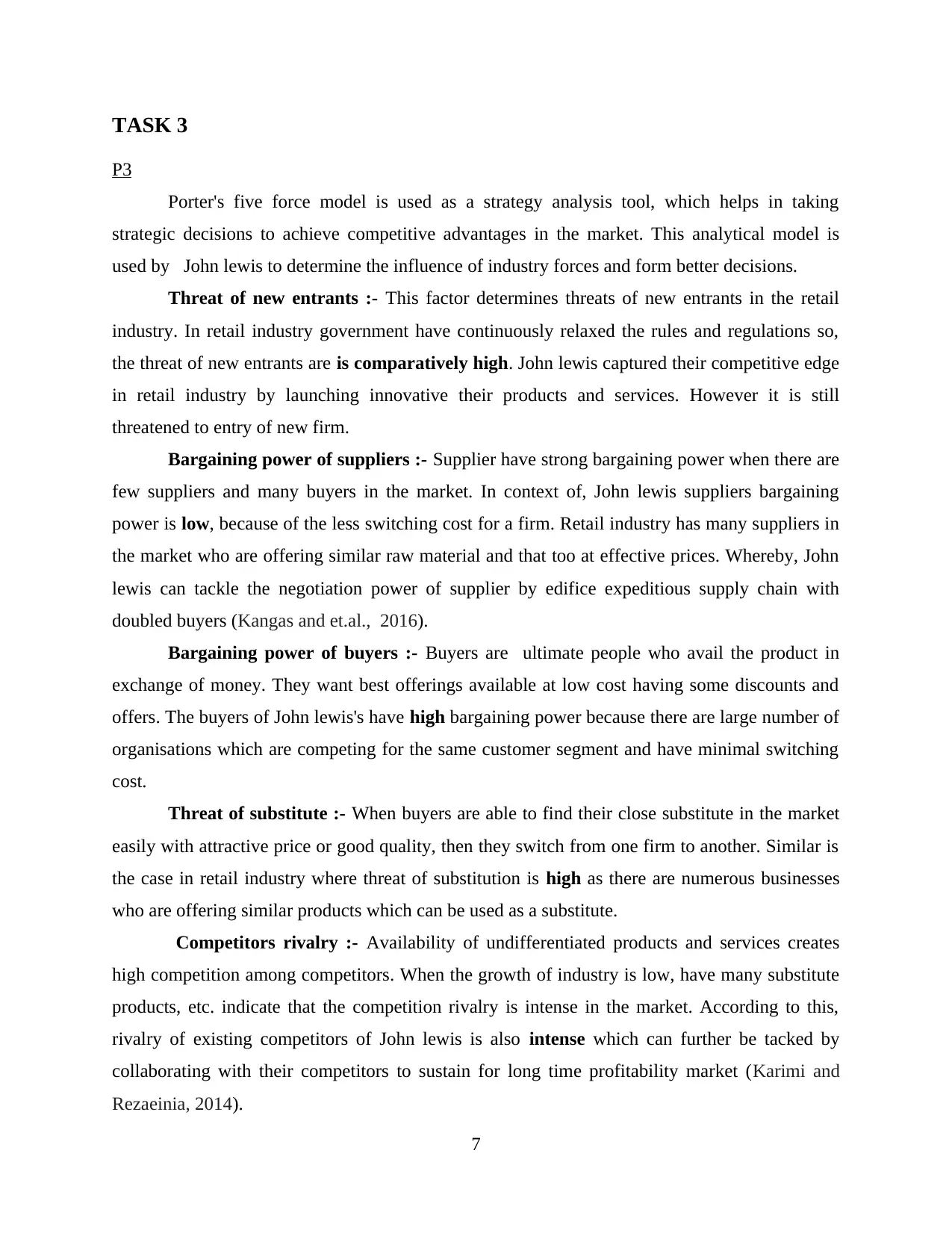
TASK 3
P3
Porter's five force model is used as a strategy analysis tool, which helps in taking
strategic decisions to achieve competitive advantages in the market. This analytical model is
used by John lewis to determine the influence of industry forces and form better decisions.
Threat of new entrants :- This factor determines threats of new entrants in the retail
industry. In retail industry government have continuously relaxed the rules and regulations so,
the threat of new entrants are is comparatively high. John lewis captured their competitive edge
in retail industry by launching innovative their products and services. However it is still
threatened to entry of new firm.
Bargaining power of suppliers :- Supplier have strong bargaining power when there are
few suppliers and many buyers in the market. In context of, John lewis suppliers bargaining
power is low, because of the less switching cost for a firm. Retail industry has many suppliers in
the market who are offering similar raw material and that too at effective prices. Whereby, John
lewis can tackle the negotiation power of supplier by edifice expeditious supply chain with
doubled buyers (Kangas and et.al., 2016).
Bargaining power of buyers :- Buyers are ultimate people who avail the product in
exchange of money. They want best offerings available at low cost having some discounts and
offers. The buyers of John lewis's have high bargaining power because there are large number of
organisations which are competing for the same customer segment and have minimal switching
cost.
Threat of substitute :- When buyers are able to find their close substitute in the market
easily with attractive price or good quality, then they switch from one firm to another. Similar is
the case in retail industry where threat of substitution is high as there are numerous businesses
who are offering similar products which can be used as a substitute.
Competitors rivalry :- Availability of undifferentiated products and services creates
high competition among competitors. When the growth of industry is low, have many substitute
products, etc. indicate that the competition rivalry is intense in the market. According to this,
rivalry of existing competitors of John lewis is also intense which can further be tacked by
collaborating with their competitors to sustain for long time profitability market (Karimi and
Rezaeinia, 2014).
7
P3
Porter's five force model is used as a strategy analysis tool, which helps in taking
strategic decisions to achieve competitive advantages in the market. This analytical model is
used by John lewis to determine the influence of industry forces and form better decisions.
Threat of new entrants :- This factor determines threats of new entrants in the retail
industry. In retail industry government have continuously relaxed the rules and regulations so,
the threat of new entrants are is comparatively high. John lewis captured their competitive edge
in retail industry by launching innovative their products and services. However it is still
threatened to entry of new firm.
Bargaining power of suppliers :- Supplier have strong bargaining power when there are
few suppliers and many buyers in the market. In context of, John lewis suppliers bargaining
power is low, because of the less switching cost for a firm. Retail industry has many suppliers in
the market who are offering similar raw material and that too at effective prices. Whereby, John
lewis can tackle the negotiation power of supplier by edifice expeditious supply chain with
doubled buyers (Kangas and et.al., 2016).
Bargaining power of buyers :- Buyers are ultimate people who avail the product in
exchange of money. They want best offerings available at low cost having some discounts and
offers. The buyers of John lewis's have high bargaining power because there are large number of
organisations which are competing for the same customer segment and have minimal switching
cost.
Threat of substitute :- When buyers are able to find their close substitute in the market
easily with attractive price or good quality, then they switch from one firm to another. Similar is
the case in retail industry where threat of substitution is high as there are numerous businesses
who are offering similar products which can be used as a substitute.
Competitors rivalry :- Availability of undifferentiated products and services creates
high competition among competitors. When the growth of industry is low, have many substitute
products, etc. indicate that the competition rivalry is intense in the market. According to this,
rivalry of existing competitors of John lewis is also intense which can further be tacked by
collaborating with their competitors to sustain for long time profitability market (Karimi and
Rezaeinia, 2014).
7
⊘ This is a preview!⊘
Do you want full access?
Subscribe today to unlock all pages.

Trusted by 1+ million students worldwide
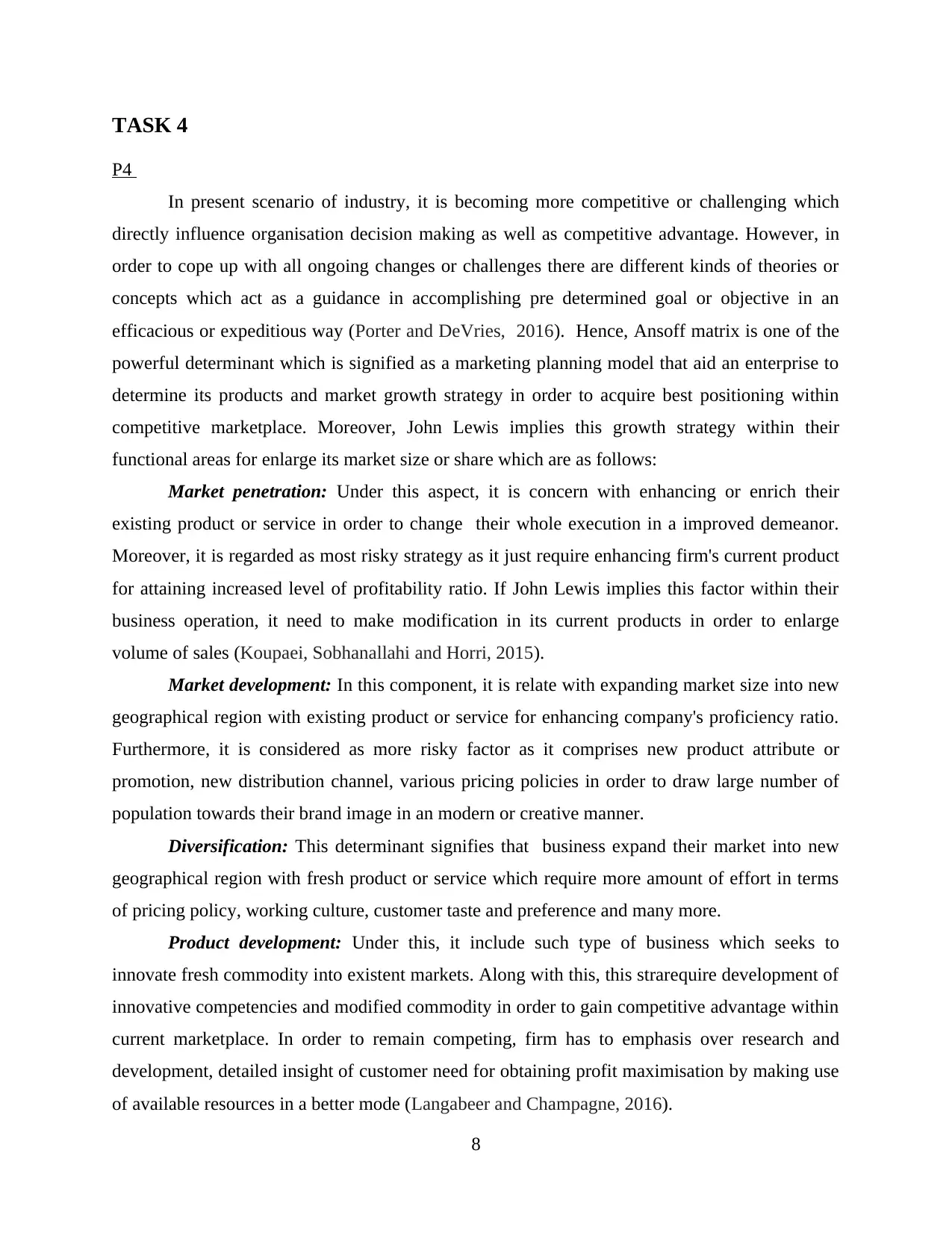
TASK 4
P4
In present scenario of industry, it is becoming more competitive or challenging which
directly influence organisation decision making as well as competitive advantage. However, in
order to cope up with all ongoing changes or challenges there are different kinds of theories or
concepts which act as a guidance in accomplishing pre determined goal or objective in an
efficacious or expeditious way (Porter and DeVries, 2016). Hence, Ansoff matrix is one of the
powerful determinant which is signified as a marketing planning model that aid an enterprise to
determine its products and market growth strategy in order to acquire best positioning within
competitive marketplace. Moreover, John Lewis implies this growth strategy within their
functional areas for enlarge its market size or share which are as follows:
Market penetration: Under this aspect, it is concern with enhancing or enrich their
existing product or service in order to change their whole execution in a improved demeanor.
Moreover, it is regarded as most risky strategy as it just require enhancing firm's current product
for attaining increased level of profitability ratio. If John Lewis implies this factor within their
business operation, it need to make modification in its current products in order to enlarge
volume of sales (Koupaei, Sobhanallahi and Horri, 2015).
Market development: In this component, it is relate with expanding market size into new
geographical region with existing product or service for enhancing company's proficiency ratio.
Furthermore, it is considered as more risky factor as it comprises new product attribute or
promotion, new distribution channel, various pricing policies in order to draw large number of
population towards their brand image in an modern or creative manner.
Diversification: This determinant signifies that business expand their market into new
geographical region with fresh product or service which require more amount of effort in terms
of pricing policy, working culture, customer taste and preference and many more.
Product development: Under this, it include such type of business which seeks to
innovate fresh commodity into existent markets. Along with this, this strarequire development of
innovative competencies and modified commodity in order to gain competitive advantage within
current marketplace. In order to remain competing, firm has to emphasis over research and
development, detailed insight of customer need for obtaining profit maximisation by making use
of available resources in a better mode (Langabeer and Champagne, 2016).
8
P4
In present scenario of industry, it is becoming more competitive or challenging which
directly influence organisation decision making as well as competitive advantage. However, in
order to cope up with all ongoing changes or challenges there are different kinds of theories or
concepts which act as a guidance in accomplishing pre determined goal or objective in an
efficacious or expeditious way (Porter and DeVries, 2016). Hence, Ansoff matrix is one of the
powerful determinant which is signified as a marketing planning model that aid an enterprise to
determine its products and market growth strategy in order to acquire best positioning within
competitive marketplace. Moreover, John Lewis implies this growth strategy within their
functional areas for enlarge its market size or share which are as follows:
Market penetration: Under this aspect, it is concern with enhancing or enrich their
existing product or service in order to change their whole execution in a improved demeanor.
Moreover, it is regarded as most risky strategy as it just require enhancing firm's current product
for attaining increased level of profitability ratio. If John Lewis implies this factor within their
business operation, it need to make modification in its current products in order to enlarge
volume of sales (Koupaei, Sobhanallahi and Horri, 2015).
Market development: In this component, it is relate with expanding market size into new
geographical region with existing product or service for enhancing company's proficiency ratio.
Furthermore, it is considered as more risky factor as it comprises new product attribute or
promotion, new distribution channel, various pricing policies in order to draw large number of
population towards their brand image in an modern or creative manner.
Diversification: This determinant signifies that business expand their market into new
geographical region with fresh product or service which require more amount of effort in terms
of pricing policy, working culture, customer taste and preference and many more.
Product development: Under this, it include such type of business which seeks to
innovate fresh commodity into existent markets. Along with this, this strarequire development of
innovative competencies and modified commodity in order to gain competitive advantage within
current marketplace. In order to remain competing, firm has to emphasis over research and
development, detailed insight of customer need for obtaining profit maximisation by making use
of available resources in a better mode (Langabeer and Champagne, 2016).
8
Paraphrase This Document
Need a fresh take? Get an instant paraphrase of this document with our AI Paraphraser
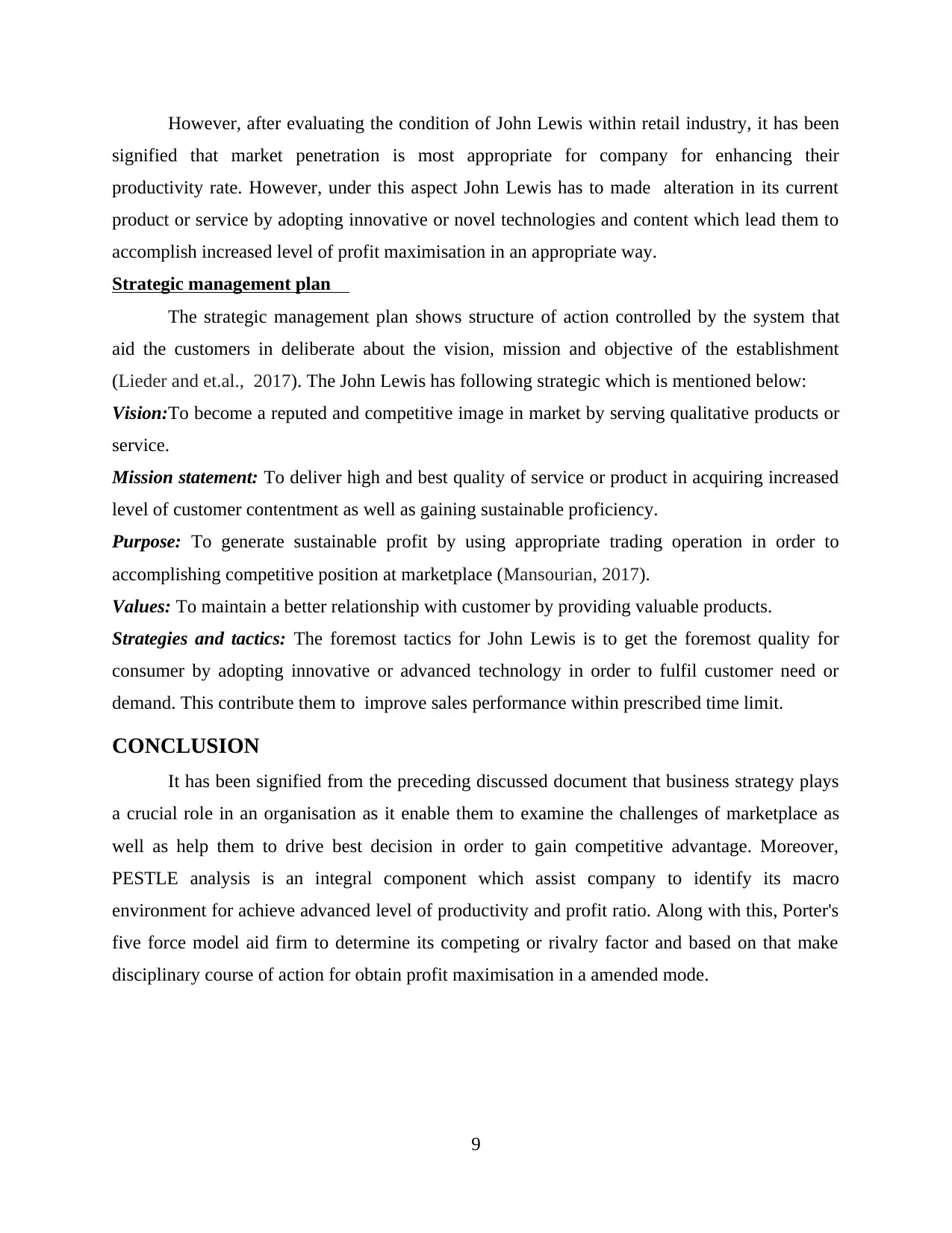
However, after evaluating the condition of John Lewis within retail industry, it has been
signified that market penetration is most appropriate for company for enhancing their
productivity rate. However, under this aspect John Lewis has to made alteration in its current
product or service by adopting innovative or novel technologies and content which lead them to
accomplish increased level of profit maximisation in an appropriate way.
Strategic management plan
The strategic management plan shows structure of action controlled by the system that
aid the customers in deliberate about the vision, mission and objective of the establishment
(Lieder and et.al., 2017). The John Lewis has following strategic which is mentioned below:
Vision:To become a reputed and competitive image in market by serving qualitative products or
service.
Mission statement: To deliver high and best quality of service or product in acquiring increased
level of customer contentment as well as gaining sustainable proficiency.
Purpose: To generate sustainable profit by using appropriate trading operation in order to
accomplishing competitive position at marketplace (Mansourian, 2017).
Values: To maintain a better relationship with customer by providing valuable products.
Strategies and tactics: The foremost tactics for John Lewis is to get the foremost quality for
consumer by adopting innovative or advanced technology in order to fulfil customer need or
demand. This contribute them to improve sales performance within prescribed time limit.
CONCLUSION
It has been signified from the preceding discussed document that business strategy plays
a crucial role in an organisation as it enable them to examine the challenges of marketplace as
well as help them to drive best decision in order to gain competitive advantage. Moreover,
PESTLE analysis is an integral component which assist company to identify its macro
environment for achieve advanced level of productivity and profit ratio. Along with this, Porter's
five force model aid firm to determine its competing or rivalry factor and based on that make
disciplinary course of action for obtain profit maximisation in a amended mode.
9
signified that market penetration is most appropriate for company for enhancing their
productivity rate. However, under this aspect John Lewis has to made alteration in its current
product or service by adopting innovative or novel technologies and content which lead them to
accomplish increased level of profit maximisation in an appropriate way.
Strategic management plan
The strategic management plan shows structure of action controlled by the system that
aid the customers in deliberate about the vision, mission and objective of the establishment
(Lieder and et.al., 2017). The John Lewis has following strategic which is mentioned below:
Vision:To become a reputed and competitive image in market by serving qualitative products or
service.
Mission statement: To deliver high and best quality of service or product in acquiring increased
level of customer contentment as well as gaining sustainable proficiency.
Purpose: To generate sustainable profit by using appropriate trading operation in order to
accomplishing competitive position at marketplace (Mansourian, 2017).
Values: To maintain a better relationship with customer by providing valuable products.
Strategies and tactics: The foremost tactics for John Lewis is to get the foremost quality for
consumer by adopting innovative or advanced technology in order to fulfil customer need or
demand. This contribute them to improve sales performance within prescribed time limit.
CONCLUSION
It has been signified from the preceding discussed document that business strategy plays
a crucial role in an organisation as it enable them to examine the challenges of marketplace as
well as help them to drive best decision in order to gain competitive advantage. Moreover,
PESTLE analysis is an integral component which assist company to identify its macro
environment for achieve advanced level of productivity and profit ratio. Along with this, Porter's
five force model aid firm to determine its competing or rivalry factor and based on that make
disciplinary course of action for obtain profit maximisation in a amended mode.
9
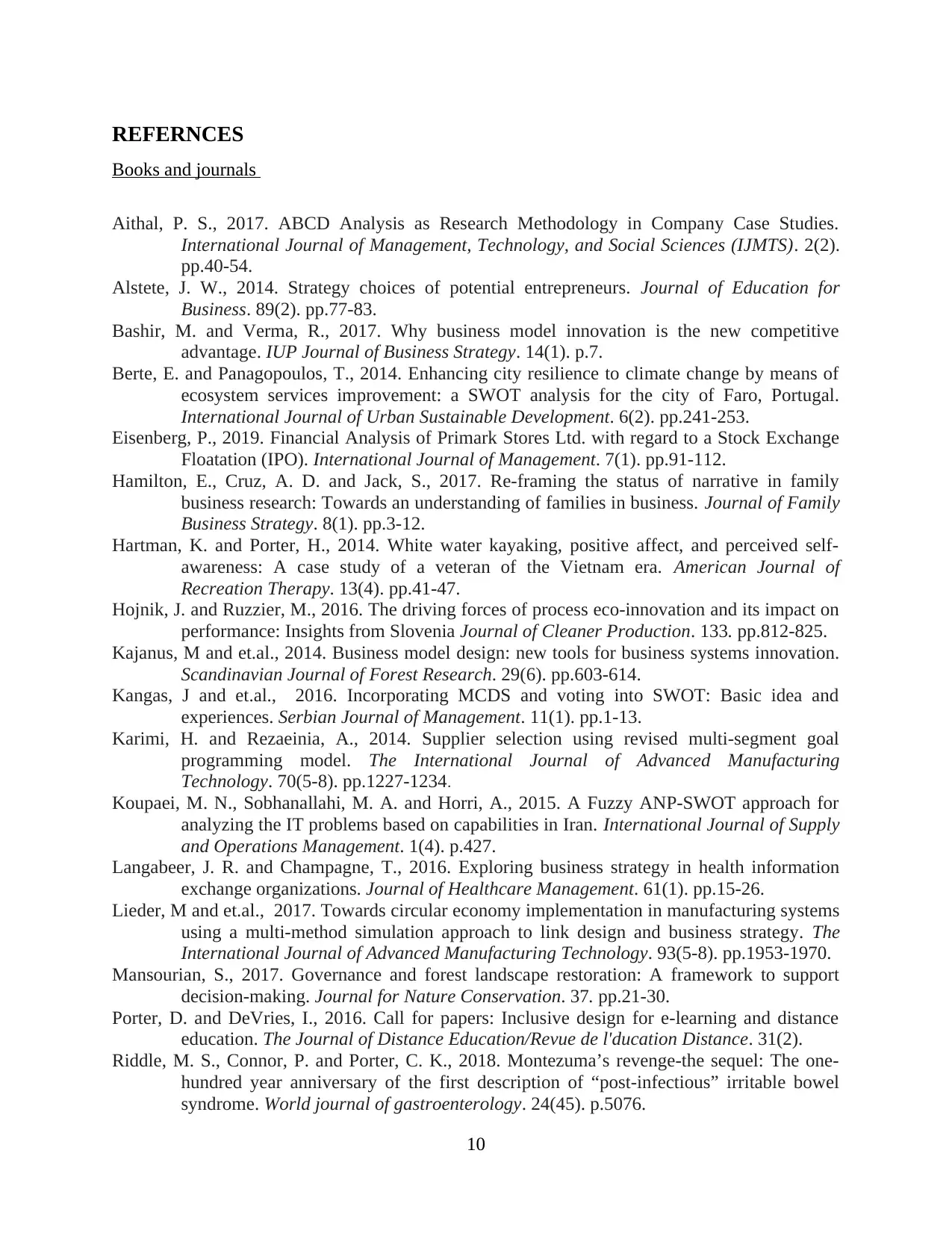
REFERNCES
Books and journals
Aithal, P. S., 2017. ABCD Analysis as Research Methodology in Company Case Studies.
International Journal of Management, Technology, and Social Sciences (IJMTS). 2(2).
pp.40-54.
Alstete, J. W., 2014. Strategy choices of potential entrepreneurs. Journal of Education for
Business. 89(2). pp.77-83.
Bashir, M. and Verma, R., 2017. Why business model innovation is the new competitive
advantage. IUP Journal of Business Strategy. 14(1). p.7.
Berte, E. and Panagopoulos, T., 2014. Enhancing city resilience to climate change by means of
ecosystem services improvement: a SWOT analysis for the city of Faro, Portugal.
International Journal of Urban Sustainable Development. 6(2). pp.241-253.
Eisenberg, P., 2019. Financial Analysis of Primark Stores Ltd. with regard to a Stock Exchange
Floatation (IPO). International Journal of Management. 7(1). pp.91-112.
Hamilton, E., Cruz, A. D. and Jack, S., 2017. Re-framing the status of narrative in family
business research: Towards an understanding of families in business. Journal of Family
Business Strategy. 8(1). pp.3-12.
Hartman, K. and Porter, H., 2014. White water kayaking, positive affect, and perceived self-
awareness: A case study of a veteran of the Vietnam era. American Journal of
Recreation Therapy. 13(4). pp.41-47.
Hojnik, J. and Ruzzier, M., 2016. The driving forces of process eco-innovation and its impact on
performance: Insights from Slovenia Journal of Cleaner Production. 133. pp.812-825.
Kajanus, M and et.al., 2014. Business model design: new tools for business systems innovation.
Scandinavian Journal of Forest Research. 29(6). pp.603-614.
Kangas, J and et.al., 2016. Incorporating MCDS and voting into SWOT: Basic idea and
experiences. Serbian Journal of Management. 11(1). pp.1-13.
Karimi, H. and Rezaeinia, A., 2014. Supplier selection using revised multi-segment goal
programming model. The International Journal of Advanced Manufacturing
Technology. 70(5-8). pp.1227-1234.
Koupaei, M. N., Sobhanallahi, M. A. and Horri, A., 2015. A Fuzzy ANP-SWOT approach for
analyzing the IT problems based on capabilities in Iran. International Journal of Supply
and Operations Management. 1(4). p.427.
Langabeer, J. R. and Champagne, T., 2016. Exploring business strategy in health information
exchange organizations. Journal of Healthcare Management. 61(1). pp.15-26.
Lieder, M and et.al., 2017. Towards circular economy implementation in manufacturing systems
using a multi-method simulation approach to link design and business strategy. The
International Journal of Advanced Manufacturing Technology. 93(5-8). pp.1953-1970.
Mansourian, S., 2017. Governance and forest landscape restoration: A framework to support
decision-making. Journal for Nature Conservation. 37. pp.21-30.
Porter, D. and DeVries, I., 2016. Call for papers: Inclusive design for e-learning and distance
education. The Journal of Distance Education/Revue de l'ducation Distance. 31(2).
Riddle, M. S., Connor, P. and Porter, C. K., 2018. Montezuma’s revenge-the sequel: The one-
hundred year anniversary of the first description of “post-infectious” irritable bowel
syndrome. World journal of gastroenterology. 24(45). p.5076.
10
Books and journals
Aithal, P. S., 2017. ABCD Analysis as Research Methodology in Company Case Studies.
International Journal of Management, Technology, and Social Sciences (IJMTS). 2(2).
pp.40-54.
Alstete, J. W., 2014. Strategy choices of potential entrepreneurs. Journal of Education for
Business. 89(2). pp.77-83.
Bashir, M. and Verma, R., 2017. Why business model innovation is the new competitive
advantage. IUP Journal of Business Strategy. 14(1). p.7.
Berte, E. and Panagopoulos, T., 2014. Enhancing city resilience to climate change by means of
ecosystem services improvement: a SWOT analysis for the city of Faro, Portugal.
International Journal of Urban Sustainable Development. 6(2). pp.241-253.
Eisenberg, P., 2019. Financial Analysis of Primark Stores Ltd. with regard to a Stock Exchange
Floatation (IPO). International Journal of Management. 7(1). pp.91-112.
Hamilton, E., Cruz, A. D. and Jack, S., 2017. Re-framing the status of narrative in family
business research: Towards an understanding of families in business. Journal of Family
Business Strategy. 8(1). pp.3-12.
Hartman, K. and Porter, H., 2014. White water kayaking, positive affect, and perceived self-
awareness: A case study of a veteran of the Vietnam era. American Journal of
Recreation Therapy. 13(4). pp.41-47.
Hojnik, J. and Ruzzier, M., 2016. The driving forces of process eco-innovation and its impact on
performance: Insights from Slovenia Journal of Cleaner Production. 133. pp.812-825.
Kajanus, M and et.al., 2014. Business model design: new tools for business systems innovation.
Scandinavian Journal of Forest Research. 29(6). pp.603-614.
Kangas, J and et.al., 2016. Incorporating MCDS and voting into SWOT: Basic idea and
experiences. Serbian Journal of Management. 11(1). pp.1-13.
Karimi, H. and Rezaeinia, A., 2014. Supplier selection using revised multi-segment goal
programming model. The International Journal of Advanced Manufacturing
Technology. 70(5-8). pp.1227-1234.
Koupaei, M. N., Sobhanallahi, M. A. and Horri, A., 2015. A Fuzzy ANP-SWOT approach for
analyzing the IT problems based on capabilities in Iran. International Journal of Supply
and Operations Management. 1(4). p.427.
Langabeer, J. R. and Champagne, T., 2016. Exploring business strategy in health information
exchange organizations. Journal of Healthcare Management. 61(1). pp.15-26.
Lieder, M and et.al., 2017. Towards circular economy implementation in manufacturing systems
using a multi-method simulation approach to link design and business strategy. The
International Journal of Advanced Manufacturing Technology. 93(5-8). pp.1953-1970.
Mansourian, S., 2017. Governance and forest landscape restoration: A framework to support
decision-making. Journal for Nature Conservation. 37. pp.21-30.
Porter, D. and DeVries, I., 2016. Call for papers: Inclusive design for e-learning and distance
education. The Journal of Distance Education/Revue de l'ducation Distance. 31(2).
Riddle, M. S., Connor, P. and Porter, C. K., 2018. Montezuma’s revenge-the sequel: The one-
hundred year anniversary of the first description of “post-infectious” irritable bowel
syndrome. World journal of gastroenterology. 24(45). p.5076.
10
⊘ This is a preview!⊘
Do you want full access?
Subscribe today to unlock all pages.

Trusted by 1+ million students worldwide
1 out of 13
Related Documents
Your All-in-One AI-Powered Toolkit for Academic Success.
+13062052269
info@desklib.com
Available 24*7 on WhatsApp / Email
![[object Object]](/_next/static/media/star-bottom.7253800d.svg)
Unlock your academic potential
Copyright © 2020–2025 A2Z Services. All Rights Reserved. Developed and managed by ZUCOL.





